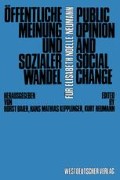Abstract
It is strange, but true, that public opinion research, mass communications research and public opinion theory have become disconnected. It is difficult even to explain how any one of these can exist without the others, and yet the fact is that each has wandered off on its own. It is to the great credit of Elisabeth Noelle-Neumann that she has taken the lead in trying to bring them together again.1 Beginning with her call for a “return to a theory of powerful mass media”, Noelle-Neumann has been trying to show how the dynamics of media production and the dynamics of opinion formation interact, and how the process of this interaction can be described empirically by means of creative polling techniques.2 There may be room for debate over her inferences from the data, but nobody can underestimate the importance of her attempt to put the whole together.
Access this chapter
Tax calculation will be finalised at checkout
Purchases are for personal use only
Preview
Unable to display preview. Download preview PDF.
Notes
Elisabeth Noelle-Neumann, “Return to the Concept of Powerful Mass Media”, in H. Eguchi and K. Sata (eds.) Studies of Broadcasting, No. 9, NHK, Tokyo, 1973, pp. 67–112.
In addition to the 1973 paper, ibid., I draw on the following writings of Elisabeth Noelle-Neumann: “Spiral of Silence: A Theory of Public Opinion”, Journal of Communication, Vol. 24, 1974, pp. 43–51; “Turbulences in the Climate of Opinion: Methodological Applications of the Spiral of Silence Theory”, Public Opinion Quarterly, Vol. 41, 1977, pp. 143-158; and “Mass Media and Social Change in Developed Societies”, in Elihu Katz and Tamas Szecsko, (eds.), Mass Media and Social Change, London: Sage Ltd., 1981.
Textbook discussions of the concept of “pluralistic ignorance” can be found in Theodore Newcomb, Social Psychology, Dryden, New York 1950, and in David Krech, Richard S. Crutchfield and Egerton L. Ballachey, Individual in Society, McGraw-Hill, New York, 1972.
Solomon E. Asch, “Effects of Group Pressure Upon the Modification and Distortion of Judgments”, in E. Maccoby, T. Newcomb and P. Hartley (eds.) Readings in Social Psychology, 3rd edition, Holt, New York 1958. See also the Crutchfield technique as described in Kretch et al., Individual in Society, op. cit., pp. 509-512.
Paul F. Lazarsfeld and Robert K. Merton, “Mass Communication, Popular Taste and Organized Social Action”, (1948), reprinted in Wilbur Schramm and Donald Roberts (eds.) Process and Effects of Mass Communication, University of Illinois Press, Urbana ill. 1971.
A sophisticated discussion of this problem is Alvin Gouldner, Dialectics of Ideology and Technology, Macmillan, London 1976.
James S. Coleman, “Authority Systems”, Public Opinion Quarterly, Vol 44, 1980, pp. 143–163.
These cases are discussed in Dina Goren, Secrecy and the Right to Know, Turtledove Press, Tel Aviv, 1979.
For a discussion of these models, see Elihu Katz, “On Conceptualizing Media Effects”, in Thelma McCormack (ed.) Studies in Communication, Vol. I, JAI Press, Bridgeport, Conn., 1980.
See Todd Gitlin, “Media Sociology: The Dominant Paradigm”, Theory and Society Vol. 6, 1978, pp. 205–253.
This paper is in sharp criticism of Elihu Katz and Paul Lazarsfeld, Personal Influence, The Free Press, Glencoe, 1956.
See George Gerbner and Larry Gross, “Living with Television: The Violence Profile”, Journal of Communication, Vol. 26, 1976, pp. 173–199, and a series of subsequent papers by these authors and their associates, in the same journal, in succeeding years.
See Paul M. Hirsch, “The’ scary World’ of the Nonviewer and Other Anomalies: A Reanalysis of Gerbner et al’s Findings on Cultivation Analysis, Part I and Part II”, Communication Research, Vol. 7, 1980, pp. 403–456, and Vol. 8, 1981.
Michael Hughes, “The Fruits of Cultivation Analysis: A Reexamination of Some Effects of Television Watching”, Public Opinion Quarterly, Vol. 44, 1980, pp. 287–302.
J. M. Wober, “Televised Violence and Paranoid Perception: The View from Great Britain”, Public Opinion Quarterly, Vol. 42, 1978, pp. 315–321. A detailed reply appears in George Gerbner, Larry Gross, Michael Morgan and Nancy Signorielli, “A Curious Journey into the Scary World of Paul Hirsch”, Communication Research, Vol. 8, 1981.
The classic discussion of this concept is Robert K. Merton and Alice Kitt, “Contributions to the Theory of Reference Group Behavior”, in R. K. Merton and P. F. Lazarsfeld (eds.) Studies in the Scope and Method of the American Soldier, Free Press, Glencoe, 1950, pp. 40–105. See also continued discussions of this topic in the several recent editions of R.K. Merton, Social Theory and Social Structure, Macmillan-Free Press, New York. Pioneer of this field is Herbert H. Hyman, “The Psychology of Status”, Archives of Psychology, 1942, No. 269.
Editor information
Editors and Affiliations
Rights and permissions
Copyright information
© 1981 Westdeutscher Verlag GmbH, Opladen
About this chapter
Cite this chapter
Katz, E. (1981). Publicity and Pluralistic Ignorance: Notes on ‘The Spiral of Silence’. In: Baier, H., Kepplinger, H.M., Reumann, K. (eds) Öffentliche Meinung und sozialer Wandel / Public Opinion and Social Change. VS Verlag für Sozialwissenschaften. https://doi.org/10.1007/978-3-322-87749-9_2
Download citation
DOI: https://doi.org/10.1007/978-3-322-87749-9_2
Publisher Name: VS Verlag für Sozialwissenschaften
Print ISBN: 978-3-531-11533-7
Online ISBN: 978-3-322-87749-9
eBook Packages: Springer Book Archive

